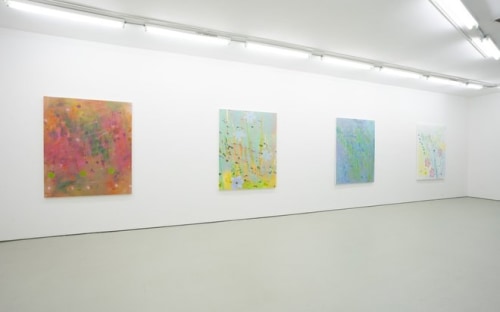Richard Galling’s ‘Popular Emotion’ at Green Gallery
A stunning array of canvasses explores the ambiguous interplay between painting-as-structure and painting-as-painting.
3/12/25
Back
'Popular Emotion' at The Green Gallery
Some would say we are going through a golden age of painting. Especially those old enough to remember the obituaries that piled up for it in the ‘90s. Compared to then, painting looks miraculously healthy. Its practitioners are proliferating, its forms are diverse, and its fans are many. But still, a lingering question puzzled me as I took in Richard Galling’s exhibition of canvases at The Green Gallery through March 31, tellingly titled “Popular Emotion,” about how much of this ascendency reflects actual depth and solidity and how much is gilded artifice driven by painting’s friendliness to social media.
Seeing Galling’s stunning array of canvases led me to believe that it could be both; that gold and gilt might survive side-by-side in a fairytale forever-after. flowers, a 60 x 48-inch canvas appears light and lush from the entryway with a chain of phthalo blue bursts within a passage of lemon-yellow, all of it dancing above a more objective bed of pale red flowers in the lower half. The faintest sense of a tree line along a horizon reinforces a sense of landscape; however, the sense of representation sinks easily into pure painterliness, hinting at Galling’s deeper interests about painting’s x’s and o’s.
The ambiguous interplay between painting-as-structure and painting-as-painting continues through the main gallery. Structure comes later in the game though; the works seduce us first with surface, color and paint chops before unpacking the more rigorous opportunity. suggestions of flora, for instance, another 60 x 48-inch canvas in the front room, builds from a washy nebula of greens and oranges under a foreground of vermillion dashes, permanent green circles and snaking pink ribbons. The gestural licks on top of the obscured surface evoke Monet’s grand-scale water lily paintings, the ones he painted through cataracts. Galling’s long lens effect arises from 20/20 vision though, with his own shimmering fields of scumbled, offsetting hues providing a platform for that secondary narrative to push.
Image and Structure
It's in the back room of The Green Gallery that Galling pulls out the big book of painting grammar. There, imagery emerges into patterns that were harder to spot in the main space. Those flowers are back and so are the circles. And the slightest implication of a grid articulates the interiors of the compositions. A logic builds that might be retroactively applied to the entire exhibition. I did a little Chaz Palminteri coffee cup drop in my head when I realized. The bloom in the painting flowers and grid confirms the structural underpinnings of these works through both its form and its title. The flowers in the piece are architecture as much as they are mark. They’re text as much as image; saying flowers more than depicting them.
This places each of these floral paintings somewhere in the middle of Warhol deadpan, Allan McCollum’s Surrogates and Sigmar Polke’s punchy post-pop. Which of course leaves the story of bravura painting and seductive color on the sideline for a moment. And those balls that were green in suggestions of flora are silver in untitled, but otherwise they’re the same object, at the same longitude, at the same intervals. They’re painted with the touch of Velasquez, but function like a diagram pulled out of one of Rosalind Krauss’s dreams.
I left the show still processing it all before looking back from the parking lot. From the sidewalk all that loaded and layered information re-congealed into what appeared through the glass to be monochromatic abstractions. It seems that some painting requires action, reaction and perspective after all. Paintings made for the physical universe at least. The digital universe meanwhile is slowly inventing a separate set of rules based on compression and consent. The two worlds can probably live happily ever after, with one flattened for the phone and the other using that flatness as its steppingstone. One races to the bottom and the other soars, revealing the many thrills and dynamic contradictions that come from haptic meetings between human eyes and the paintings made for it.
by Shane McAdams